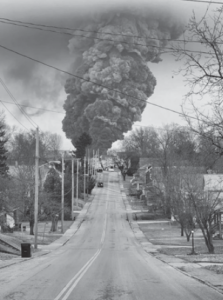A PSR train wreck
The major fiery train wreck in Ohio last month serves as a reminder of just how potentially dangerous long and heavy trains can be. Add to this the fact that in the last 10 years, Class One rail carriers have dramatically increased both the length and tonnage of the average train, while cutting back on maintenance workers and inspection times, and we have a time bomb ticking. A decade ago, similar problems led up to the Canadian disaster that destroyed a whole town and took the lives of 47 people.

Thousands of people in Palestine, OH were evacuated, property damage to both rail and non-railroad property will no doubt soar into the millions. Still, we dodged a bullet as no rail workers and no trackside residents were killed. This time.
The train, NS 32N, part of Norfolk Southern Co., was built in Madison, IL and headed east to Conway, PA. The train swapped out crews in Decatur, IL. The new crew experienced trouble while running their route between Decatur, IL and Peru, IN. In fact, they didn’t complete their trip to Peru since they exceeded the federal hours-of-service statute. The train severed a knuckle between two cars at Attica, IN. This occurred while the train was going downhill and while in dynamic braking.
Pretty much the only time a train breaks in this scenario is when the train isn’t blocked properly. In order to mitigate in-train forces, railroads prior to PSR (Precision Rail Scheduling – an automatic override) composed trains with heavier cars on the head end and lighter cars on the rear end. This arrangement prevents severe slack run-ins and run-outs throughout a trip.
Last year Norfolk Southern paid $4.16 in dividends per share with 247 million shares outstanding
If a train’s emergency brakes are applied in this arrangement, you don’t have heavier cars running into lighter cars and causing jackknifing. Train NS 32N had 40% of its weight at the rear third of the train. Most of this tonnage was made up of loaded tank cars. The contents of these very heavy cars slosh back and forth when coming to a sudden stop.
This sloshing at a stop can continue, pushing more cars off a track in a jackknifing situation. This is what occurred in the Ohio wreck. The block of tank cars was placed directly behind a block of cars equipped with cushioned draw bars, in the middle of the train.
Drawbars on these cars are intended to slide in and out independent of the car body in order to protect the merchandise inside from damage. These types of drawbars are usually on vehicle carriers to prevent the cars/trucks inside from being damaged.
Putting cars with these drawbars in the middle of a train creates elasticity. Building a train like this (Locomotives, which are the heaviest part of any train at the head, followed by heavy mixed-freight loads, followed by a block of cushioned drawbar cars; followed by a block of heavy tank cars (such as the case with this 32N) is akin to placing two bowling balls on the ends of a rubber band and praying the rubber band doesn’t break.
Video footage has emerged online (see video link below) showing one of the wheels on this train on fire. If this footage is authentic, it’s very likely that this car caused the derailment. The damaged car apparently was allowed to leave its initial terminal because it wasn’t inspected properly. Norfolk Southern, like the rest of the industry, has laid off inspectors and dramatically reduced the time allowed for per-car inspection. In a scenario where the wheel was on fire and damaged, the train would have gone into emergency stop. The heavy tank cars on the rear end would have slammed into the derailed cars causing the 50 cars to pile up off the track and catch fire.
“Precision Scheduled Railroading” is more than likely a major culprit in this incident for the following reasons:
- Inspection times have been cut resulting in the defective car remaining in the consist.
- The train was excessively long and heavy… 151 cars, 9300 feet, 18,000 tons.
- The train was not blocked properly because PSR calls for limited “car dwell” times in terminals.
Blocking a train for proper train handling (placing the majority of weight on the head end, and ahead of cushioned drawbar cars) takes longer—so rail company owners have mostly eliminated this practice
Documents show that when current transportation safety rules were first created, a federal agency sided with industry lobbyists and limited regulations governing the transport of hazardous compounds. The decision effectively exempted many trains hauling dangerous materials—including the one in Ohio—from the “high-hazard” classification and its more stringent safety requirements.
Amid the lobbying blitz against stronger transportation safety regulations, Norfolk Southern paid executives millions and spent billions on stock buybacks—all while the company got rid of thousands of employees despite warnings that understaffing is intensifying safety risks. Norfolk Southern officials also fought off a shareholder initiative that could have required company executives to “assess, review, and mitigate risks of hazardous material transportation.”
Railroad Workers United is an inter-union, cross-craft solidarity “caucus” of railroad workers and their supporters, from all crafts, all carriers, and all unions across North America.
Be First to Comment